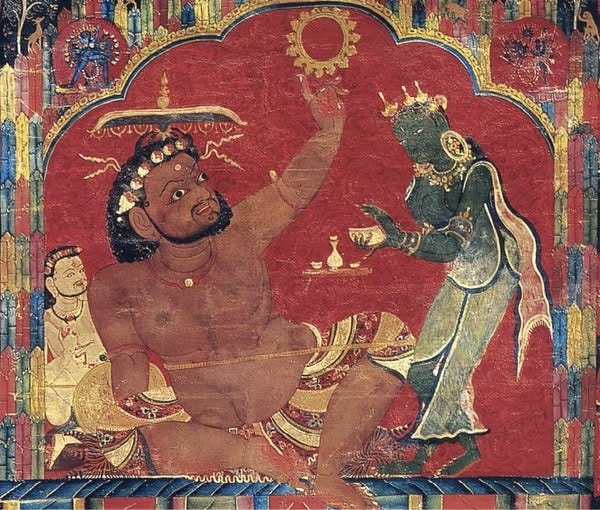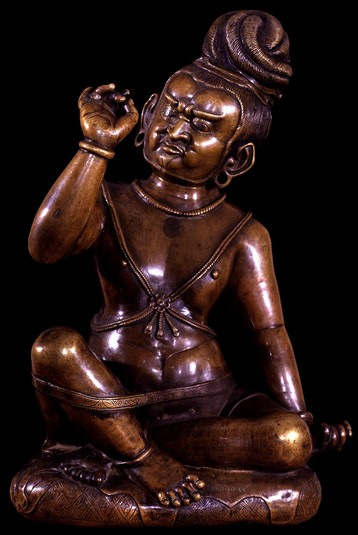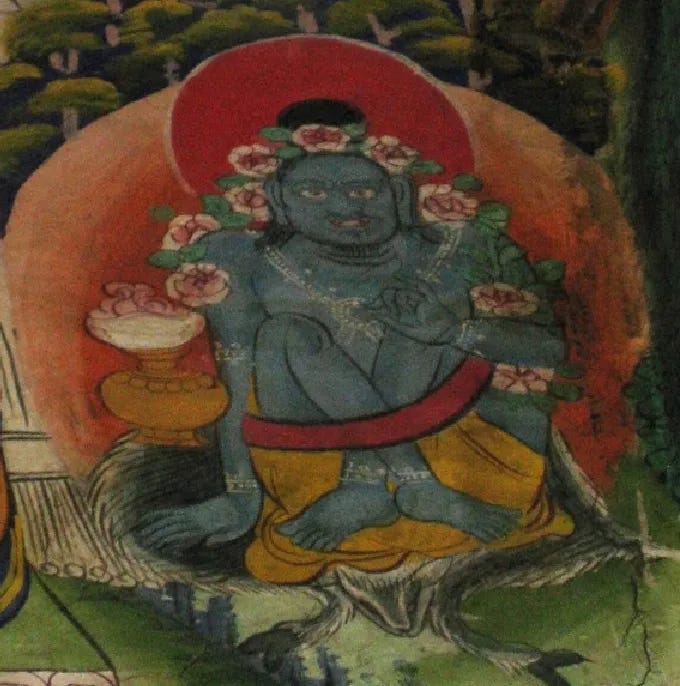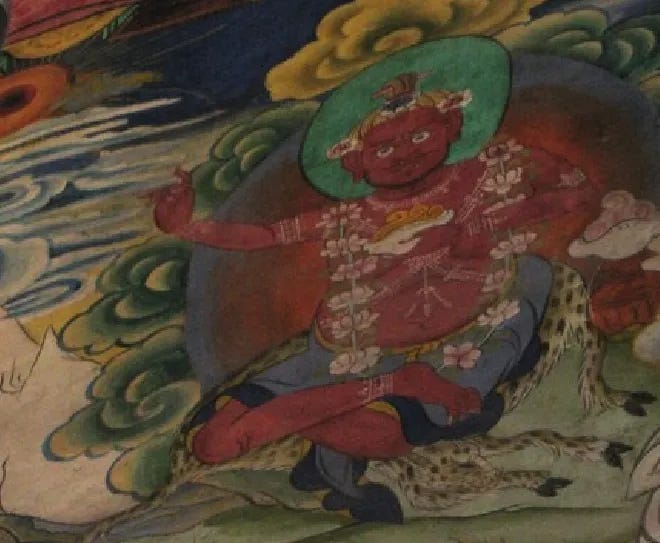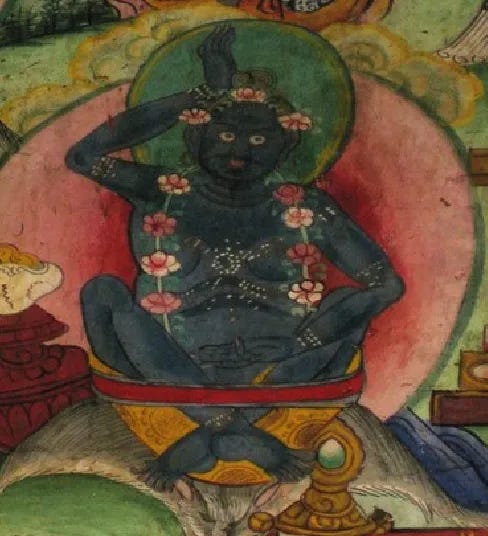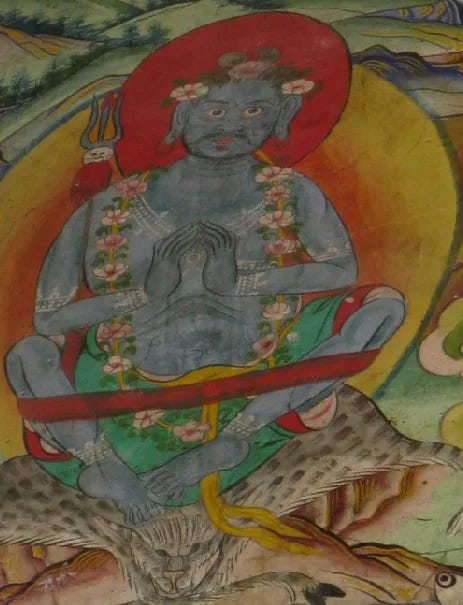The Legend of Virupa as Told by Taranatha
Translator’s Note
Amṛtasiddhi has become an important text in the field of Haṭha Yoga, as it is the earliest known text to teach some key practices of this tradition. Click here to read my article on the Tibetan Amṛtasiddhi text: Yoga Posture and Forceful Yoga: The Tibetan Amṛtasiddhi Text by Amoghavajra. According to some medieval Tibetan scholars, the teachings of Amṛtasiddhi are attributed not to the well-known Mahāsiddha Virūpa but to the Black Virūpa or Junior Virūpa. We know almost nothing about this Black Virūpa or Junior Virūpa. In Tāranātha’s hagiography of the Indian Mahāsiddha Virūpa and his disciple, he refers to Mahāsiddha Virūpa’s disciple as “Black Virūpa” or “Junior Virūpa from Oḍḍiyāna.” This raises the possibility that the Black Virūpa who is credited with the Amṛtasiddhi teachings might be the same individual described by Tāranātha.
The one who illuminated the Sakya (Lamdre) teaching is the Yogeśvara, the senior Virūpa. He visited India three times. The junior Virūpa is the one described by Vajrāsana as “the Virūpa who wanders through the charnel ground and eats human flesh.” This is the one from whom the teachings of Vajrayoginī Vārāhī Chinnamastā (phag mo dbu bcad ma) and the teachings of Amṛtasiddhi (’Chi med grub pa’i gdams ngag) originated.—-Ngagchang Drakpa Lodoe (16th-17th century)
According to some texts, this disciple of Virūpa was one of five hundred Shaivaite ascetics with long matted hair who later became Virūpa’s disciple. Tāranātha notes that Mahāsiddha Jalandhara was his main teacher prior to meeting Virūpa. For the story of Black Virūpa, please see my previous post.
However, this does not fully prove that the Mahāsiddha Virūpa was not the source of Amṛtasiddhi—since all Indian Amṛtasiddhi texts composed by yogis and paṇḍitas attribute the teachings simply to Virūpa (or Birapa), without distinguishing between the Black Virūpa or Junior Virūpa. Nonetheless, the Tibetan tradition generally ascribes the teachings of Amṛtasiddhi—as well as the Chinnamasta Devi practices—not to the well-known Mahāsiddha Virūpa but to the Black Virūpa.
In my earlier post, I offered my perspective on how the six siddhis of Virūpa can be understood and applied to one’s inner yogic practices. To read that post, click [here].
Note: The images of Virūpa depicted in various postures are photographs of 17th-century mural paintings from Nepal, sourced from Himalayan Art Resources.
The Legend of Virupa as told by Taranatha
Virupa at Nalanda Buddhist Centre
Virupa was a pandita and monk at the renowned Nalanda Buddhist monastic center. He was also known as Dharmapala, though he should not be confused with Sthavira Dharmapala, the abbot of Nalanda. His disciple was Black Virupa (Nagpo Virupa). Due to his consumption of alcohol and his association with women (sahacaraḥ), the sangha eventually expelled him from Nalanda.
Virupa Reversing the Flow of the River Ganga
Virupa once asked a boatman to ferry him across the River Ganga. When the boatman requested payment, and Virupa had nothing to offer, he pointed his finger at the river and reversed its flow, allowing him to walk to the other side.
Virupa Stopping the Sun
In the place called Odivisha, Virupa asked a tavern woman to sell him some wine. She replied that he would have to pay for it. Then Virupa traced a mark on the ground, just above the borderline between sunlight and shadow, and said, “I will pay for the wine just before the sun crosses that mark.” Pointing his finger as if pressing the sun, he stopped it in its path and began drinking the wine. It is even said that he held the sun in place for three days. Eventually, he released the sun after the king pleaded with him and paid the bill.
Virupa Splitting the Liṅga
The king of Trilinga appointed Virupa as the head of a group of five hundred Shaivite ascetics with long matted hair (jaṭilaḥ). When asked to bow down before the statues of the Tīrthika gods, Virupa refused. Observing his refusal, the ascetics became suspicious and began to challenge him. Pressured to comply, Virupa finally bowed—and at that moment, all the statues of the Tīrthika gods shattered. The chief deity among these was Vishwanatha, a Liṅga with four faces, which split into four parts. (Afterward, when Virupa departed, he accepted one of the ascetics as his disciple. This disciple became known as Kanha, the Black One.)
Virupa Taming Chandika
Virupa once visited the Tīrthikas' temple in a place called Dakinipatta. Ordinary people who entered this offering hall would be impaled on a trident (Trishul), and human flesh-eating Dakas and Dakinis would gather around the corpses. When Virupa entered the hall, he clapped his hands, shattering the trident. The Chandika stone statue began to quake. He then struck it on the head with his hand, causing the head to roll down to its chest and lap. According to legend, the statue can still be seen with its ears attached to the body but no head. Virupa instructed her not to harm people in the future. There is also a tradition that this goddess was tamed by Gorakhanatha.




